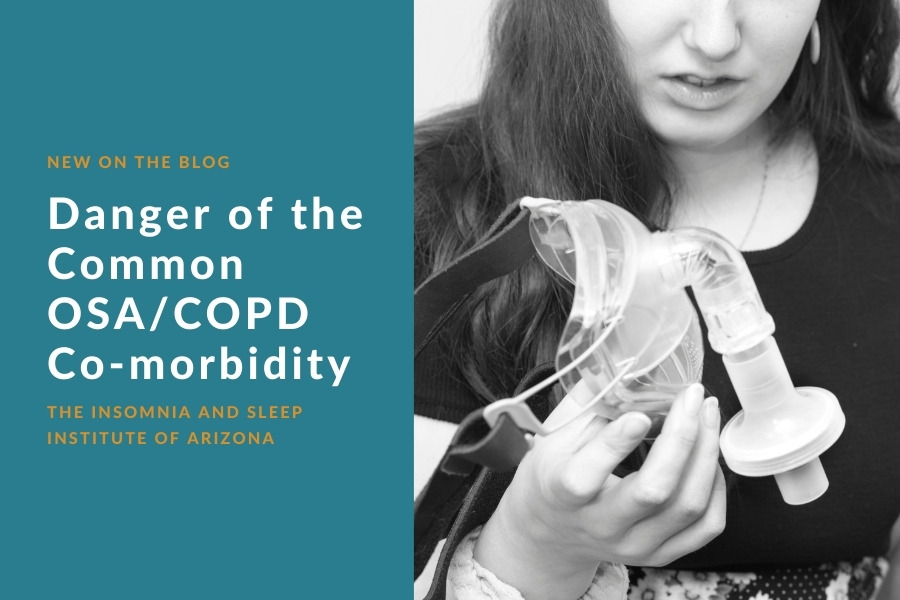The most common type of sleep apnea is obstructive sleep apnea (OSA), and many people who struggle with OSA also have chronic obstructive pulmonary disease (COPD). Recent research has shown that patients with both conditions are likelier to experience “poor outcomes.” This is why The Insomnia and Sleep Institute of Arizona is staffed by sleep specialists and is led by our Physician Director, triple board-certified Ruchir P. Patel, MD, FACP, who was recently elected the Board President of the Maricopa County Medical Society. We are proud to be the Face of Sleep Medicine in the Phoenix area, home to unprecedented staffing levels and committed to an outcome-driven approach. During your initial consultation, which requires no referral, you meet with a sleep specialist who can diagnose disorders like OSA so that testing and treatment can commence.
According to research published in BMC Pulmonary Medicine, one study shows that those with COPD have a higher rate of OSA compared to others, which leads to a “poorer quality of life” and “higher prevalence of comorbidities such as diabetes and hypertension.” This has led the lead authors to suggest that OSA screenings should be taking place when a patient is diagnosed with COPD. The study was conducted at the Xuzhou Center for Disease Control and Prevention in China. While this is a good suggestion, OSA alone can also lead to poorer outcomes, and you do not need a co-morbidity in order to get screened for this common sleep disorder.
Study Statistics: COPD and OSA
According to researchers, 66 percent of participants in the study were diagnosed with both COPD and OSA. The primary risk factors for these two issues include a higher BMI, a larger neck circumference, diabetes and hypertension at higher rates than those with “just” COPD, and a more serious Epworth Sleepiness Scale score. However, there was a lower prevalence of severe COPD in those who also had OSA.
In total, 842 patients with COPD, with a mean age of 64 and the majority of which were men, received treatment for COPD throughout 2019. Researchers considered a modified Medical Research Council (MRC) Dyspnea Scale, COPD Assessment Test, Charlson Comorbidity Index, STOP-Bang questionnaire, and Hospital Anxiety and Depression Scale along with the Epworth scale. The 66 percent figure required at least five apnea-hypopnea events while sleeping every hour.
Do You Have OSA?
There was no “significant” variation in outcome when it comes to sex, age, smoking history, history of hospitalization in the last year, or results from the MRC Dyspnea Scale according to this study (although it is known that smoking can exacerbate OSA). In reality, millions of people around the globe have OSA, and most of them are undiagnosed or mis-diagnosed. OSA sufferers temporarily stop breathing while asleep and this can cause problems both short-term and long-term. A lower quality of life (and a shorter life) is associated with untreated OSA.
The gold standard in OSA treatment has long been CPAP therapy. Today’s CPAP technology is highly advanced with options for customizing nearly every facet of the treatment machine so you can find a solution that works for you, your lifestyle, and preferences. Using CPAP every time you sleep, and correctly, is the key to regaining quality of life. The most common reason a patient does not correctly use their CPAP machine long-term is because of an incorrect fit that can be easily addressed when you work with the leading sleep experts.
Co-morbidities and OSA
There are many known co-morbidities with OSA in addition to COPD, including diabetes and hypertension. In some cases, managing your OSA through lifestyle changes (if applicable) and CPAP therapy can dramatically improve every other part of your life and even minimize or erase some co-morbidities. For the rare few who do not find success with CPAP, an implant that forces the airway to stay open while asleep may be an option. Dr. Ruchir P. Patel works with the makers of these devices, and The Insomnia and Sleep Institute is one of the few facilities in the region that can help patients with their apnea implant journey.
The most common signs of OSA, such as snoring and not feeling rested upon waking up, can often be brushed off (especially for those who do not have bedmates). There are also many signs and symptoms that are not so obvious. If you suspect that you or your child has OSA or any other sleep disorder, or if you just feel like you aren’t getting enough quality sleep, it is time to see a sleep expert. Schedule your consultation with a sleep specialist at The Insomnia and Sleep Institute today by completing the online contact form right now.





